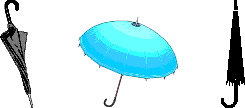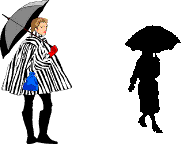

Portfolio Exercise 1: The Umbrella exercise
Portfolio Exercise 2: Perception and clever supermarket tactics
Portfolio Exercise 3: The Runaway Brain
Class exercise: Referencing & Citation (spend some time doing this in class this week with the help from your tutor)
Q: How does the way our brain works to perceive information impact on what we understand? Why does the brain sometimes make mistakes and how might this effect the communication process? What do the readings say about the relationship between perception and reality?
Week 2 – Perception: is the truth really 'out there'?
Last week we explored some communcation breakdown case studies which in part illustrated how different people, seeing, hearing and reading the "same" message or set of stimuli, may actual understand or perceive the message or communication in a different way. For this reason, an understanding of how and why humans perceive information is vital to an understanding of communication.
A good way of illustrating how perception impacts on our ability to "see" what's out there, is to look at visual illusions. We showed you some examples in the lecture but here are some more.
So how does the brain process information? Freeman (1991) says "[t]he brain transforms sensory messages into conscious perceptions almost instantly Chaotic, collective activity involving millions of neurons seems essential for such rapid recognition." Click here to read the whole article.
Other external things like alcohol and drugs can affect how we see things. Check out this article for more information.
What is perception?
Perception is the process of gathering information through our senses, organizing and making sense of it.
Previous experience and learning, attitudes and interests, needs and feelings, and the current situation all affect perception. All people do not "see" the same thing when looking at a visual image. Perception differs from individual to individual due to a variety of personal, socio-economical, and cultural differences. Age, gender, race, and past experiences are examples of personal perception filters.
Young children, teenagers, and adults "see" things differently. As they grow and develop, children learn to see and comprehend relationships and themes from visuals instead of simply seeing individual objects and shapes.
The way that we "see" or understand events, words, people and so on can be affected by different filters. These can be socio-economic such as occupation, level of education, environmental factors, and family upbringing (remember the list from Berlo's model). Or they can be cultural. Cultural filters include language, e.g. Eskimos have many unique words describing different kinds of snow. Not just adjectives that go in front of a standard word for snow, but totally different words. Customs, belief systems, and historical perspectives are other filters which change perception. Think about how supporters of different football teams interpret the decisions of a referee or an umpire.
Every characteristic of an individual influences what that individual chooses to see, hear, taste, touch, and smell. How information is interpreted to create meaning for an individual is also influenced by his/her unique make-up and background. Things like: expectations (you are scared so therefore you interpret a shadow as a burgular); previous experiences (in the rat man illusion, showing people previous drawings of animals impacted on whether they saw a man or a rat); and learning (printers or spray painters can see more minute variations in colours than the average person), will all impact on our perceptions.
Perception is part of the process of understanding visual images. Creating effective visual images depends on the appropriate use of design elements and design principles. Here are a few famous examples.
1. Can you see an old lady or a young lady? Keep looking. |
2. Do you see a man or a rat? In Freud's experiment, it depended on whether the subjects had been shown drawings of animals or humans beforehand. |
3. A pile of rocks or a man's face? Knowing it's there makes it easier to see. |
Can you read this?
| fi yuo cna raed tihs, yuo hvae a sgtrane mnid too. Cna yuo raed tihs? Olny 55 plepoe out of 100 can. i cdnuolt blveiee taht I cluod aulaclty uesdnatnrd waht I was rdanieg. The phaonmneal pweor of the hmuan mnid, aoccdrnig to a rscheearch at Cmabrigde Uinervtisy, it dseno't mtaetr in waht oerdr the ltteres in a wrod are, the olny iproamtnt tihng is taht the frsit and lsat ltteer be in the rghit pclae. The rset can be a taotl mses and you can sitll raed it whotuit a pboerlm. Tihs is bcuseae the huamn mnid deos not raed ervey lteter by istlef, but the wrod as a wlohe. Azanmig huh? yaeh and I awlyas tghuhot slpeling was ipmorantt! |
If you were able to read the above text, congratulations! This exercise demonstrates the way our brains compensate for missing or confusing information by referring to what they already know … in this case grammar and syntax. This allows us to "fill in the gaps" and to make meaning, even if all of the information is not there. It also means that sometimes we can make mistakes and fill the gaps incorrectly.
Portfolio Exercise 1: The umbrella exercise
Look at each umbrella image. Is the message of each image different? If so, what makes the message different?
Here are three more umbrella images. How do these images compare to each other? How do these images compare with the three previous ones?

What happens when the image of the umbrella includes a person? What changes about the visual message? Are there differences between these two images? If so, what are they?

Portfolio Exercise 2: Perception and clever supermarket tactics
After reading either the Sadler and Tucker extract or the Lester reading (available from the link at the top of the page) complete case study 1.5 (p.19 of your textbook). Which specific perceptual theories (eg 'halo effect', closure, figure and ground etc) explain some of the tactics the case study talks about. Can you think of other examples? Write about 250 words.
Portfolio Exercise 3: The Runaway Brain
Read Wendy Tuohy’s article called “The Runaway Brain” from this link
a. Summarise the arguments she is making about the impact of information overload on the ways our brains work. You should also refer to the information Lester (2003) and Sadler and Tucker (1981) readings (linked above).
b. Do you think modern communication technologies such as mobile phones, email and the internet might impact on our perceptual faculties? Has the advent of modern technologies impacted our ability to read more difficult texts? Write about 250 words.
Questions to think about
1. After reading the various articles on perception, can you think of other
examples of how the processes of perception impact on communication?
2. What sort of things influence why your perceptions about certain issues
(eg sport, music, political issues), differ from those of other members of
your group?
3. Why do you think some people are more "aware" or "tuned into" certain
environmental stimuli? Are women more intuitive than men?
4. Can perceptions be "learned"?
5. In the film "Matrix", Morpheus tells Neo that his perceptions
of the world are not real but are merely an artificially induced set of
neural (brain) impulses. Here's part of the clip shown in the lecture. Do you think this is possible?
Finally … just for fun
Try this quick quiz. It demonstrates some the possible mistakes our brains make.
Class exercise: Referencing & Citation
An important part of completing assignments at university is to learn how to reference and cite correctly. In this unit we will be using the APA style guide, a copy of which is also under the 'Useful docs' tab at the top of the page. In next week's class we will be learning how to find different kinds of references using the Library and electronic databases. Before coming to class, all students should attempt the Library's Successful Searching Tutorial which can be found on the Library website. Once you have completed the tutorial, have a go at the quiz on our vUWS site to check that you have understood the steps.
As a warm up, this week we will introduce you to some of the basics of referencing. Check out our new Referencing and Citation flash tutorial. This can also be found under the Flash tutorials tab.
Once you have run through this, complete either this worksheet (Word version). or this worksheet (pdf version).
Our textbook has been newly revised especially for this unit. Most lectures and many class activities will be based on the book, so we recommend that all students have access to a copy and bring it to class every week. Copies are available in the Library Closed Reserve.
In addition, class discussions and presentations will be based on more specific readings on the weekly topic. These can be found under the 'Tutorial Readings' tab at the top of this page.